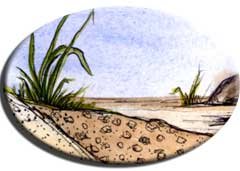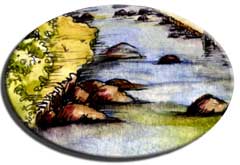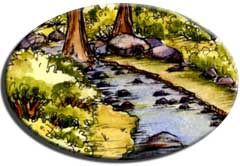Why are stream beds important?
The bottom of a stream can be made up of a variety of types of substrate, from fine clays to sands to gravels and even boulders. Each type of sediment provides a distinct type of habitat, best suited to supporting a distinct subset of stream species. Sandy or silty stream beds may support insects or warm water fishes, while gravels and boulders provide places for salmon to spawn and water to infiltrate into the subsurface to recharge the groundwater. In addition, stream beds may be fairly uniform in depth or may have deep pools, shallow riffles, and rapids. The depth and width of a stream control water movement– flows may become turbulent along rocky, shallow beds or calm across deep, silty beds. Stream beds may also support vegetation. Variation in substrate type, depth, vegetation, and bed structure helps streams provide a range of habitats that are important to for different species or different life stages of the same species.
Modifications to the form of a streambed and the type of substrate in a streambed are common. An excess of fine sediment in particular is a common management challenge because it fills the small spaces among coarse gravels and cobbles that many species rely on for feeding, hiding, and spawning.

gravels, fines & sands

cobbles & boulders

riffles & rapids
How do we measure the condition of a stream bed?
Managers can evaluate the percentage of the streambed that is covered with gravels, fines and sands, cobbles, or boulders, and assess the stream for the presence of riffles, rapids, or pools. The distribution of different grain sizes is frequently measured to understand how well sediment is balanced in a stream system. For instance the value of D50, which identifies the median grain size (that grain size where half the particles are larger and half are smaller), can be used to compare the relative coarseness of streambed material. In the California Rapid Assessment Method (CRAM) for monitoring wetland condition, streambed complexity is assessed during the evaluation of a stream’s physical structure. Many different approaches are currently used to characterize stream beds, which limits the availability of standardized datasets.

